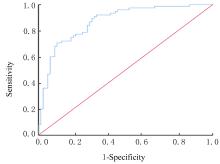吉林大学学报(医学版) ›› 2023, Vol. 49 ›› Issue (5): 1304-1309.doi: 10.13481/j.1671-587X.20230525
• 临床研究 • 上一篇
老年慢性病患者认知衰弱的危险因素分析及风险模型构建
- 1.长春中医药大学护理学院基础护理教研室, 吉林 长春 130117
2.长春中医药大学附属医院 眼科, 吉林 长春 130021
Risk factors analysis and risk model construction of cognitive frailty in elderly patients with chronic diseases
Tong SHEN1,Yang WANG1,Wei JIN1,Zhihui LIN2,Li YAN1( )
)
- 1.Department of Fundamental Nursing,School of Nursing,Changchun University of Chinese Medicine,Changchun 130117,China
2.Department of Ophthalmology,Affiliated Hospital,Changchun University of Chinese Medicine Changchun 130021,China
摘要:
目的 探讨老年慢性病患者认知衰弱的危险因素,并构建相应的风险模型。 方法 收集207例老年慢性病患者的一般临床资料,采用FRAIL量表和蒙特利尔认知评估问卷(MoCA)明确患者有无认知衰弱,并分为认知衰弱组(n=75)和非认知衰弱组(n=132)。采用单因素分析和二元Logistic回归分析明确影响老年患者认知衰弱的危险因素。 结果 所纳入的207例老年患者中,共计75例(36.23%)存在认知衰弱,2组患者年龄、体质量指数(BMI)、体育锻炼情况、工作性质、社交活动情况、夜间睡眠情况、日间精神状态及患慢性病数比较差异均有统计学意义(P<0.05)。将年龄因素进行倾向性匹配后,二元Logistic回归分析,低BMI、工作性质为体力劳动、夜间睡眠时间≤5 h、日间精神状态差和患慢性病数>2个是影响认知衰弱的危险因素。受试者工作特征曲线(ROC),本研究所构建的风险模型鉴别患者是否发生认知障碍的曲线下面积(AUC)为0.87。 结论 本研究基于危险因素构建的风险模型对老年慢性病患者认知障碍有较好的预测效能,具有潜在的临床应用前景。
中图分类号:
- R473


